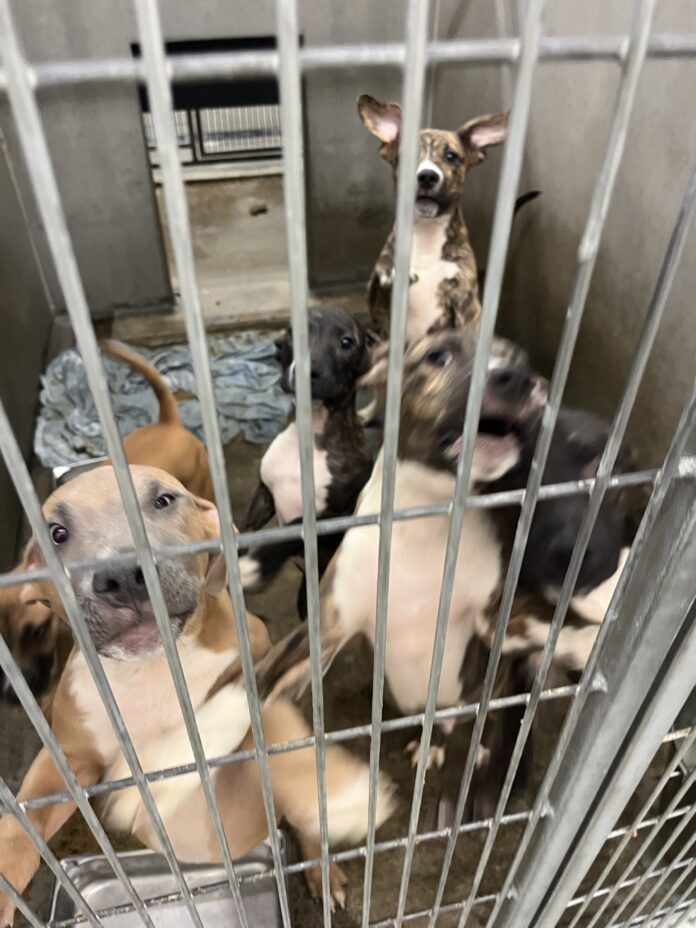I don’t think I could have survived being a shelter worker in the 1970s, when the population of dogs (and cats) getting euthanized annually in American shelters was highest. The Humane Society of the U.S. estimated that about 13.5 million animals were euthanized in the U.S. in 1973; in recent years, that number has hovered under 3 million—still too many, but far fewer than when I was a child.
However, while estimated numbers for 2023 and 2024 won’t be available for another year or two, there is plenty of anecdotal evidence that the number of euthanized pets will be far higher than the lowest historic counts. There have been a number of theories floated for this increase, from the COVID-era shortage of veterinary appointments available for spay/neuter surgery (both caused by mandatory animal hospital closures as well as the COVID-prompted retirement of many veterinarians and veterinary staff), to steep increases in the price of spay/neuter surgery (caused by both a shortage of vets and veterinary staff and high demand).
Though the causes are not entirely clear, the fact that there has been a sharp rise in the number of unwanted dogs (in particular) is evident to anyone involved in sheltering or rescue. Shelters and rescues are packed beyond capacity with adult and adolescent dogs and endless waves of puppies keep coming in year-round.
I can’t count the times that someone who had an unplanned litter of puppies told me, “It’s OK, I have homes lined up for all of the puppies!” This makes me crazy, because I know that when people are given a free puppy, very few of them follow through and obtain spay/neuter surgery; that unplanned puppy is about to go out and make a bunch more.
In online forums for community members, I often see posts from people who are seeking information about lower-cost spay/neuter surgery for their dogs—and just as often, looking to give away free puppies. I live in an economically disadvantaged town in a lower-income county, so I think I see more of this than my friends in more affluent parts of California, but I always wonder: Why can’t they just keep their dogs apart?
I know that the allure of a female dog in heat is strong, and that male dogs will do anything in their power to reach them. But surely anyone can procure a secure crate for their female dog, and back it up with a closed door or two for as many weeks as needed? How long is this? If you have an intact female dog, you had better find out! See “How Long Are Dogs in Heat.”
In a household with intact male and female dogs, what about making the neutering of the male dogs a priority? Surgery for males costs much less than females. If your own male dogs are neutered, you just have to secure your female dog indoors at home (so she’s not accosted by other intact males in the neighborhood).
Look into every voucher program or low-income assistance program in your community. Call your local animal shelter and ask for their recommendations on lower-cost spay/neuter. Call every veterinarian in your area and compare costs, asking if they offer any lower-cost appointments.
If you know someone with an intact female dog, please help them learn about how to prevent their dog’s pregnancy, point them toward a low-cost spay/neuter clinic, or do a little fundraising in your immediate social circle to help surgery happen sooner than later. Slowing the number of healthy dogs being euthanized in U.S. shelters depends on everyone doing what they can to prevent more unwanted litters from being conceived.







What about hormone-sparing spay/neuter?
You mean chemical castration
No she doesn’t – vasectomies work for dogs the same way they do for humans.
So what is hormone sparing spay/neuter?
For the males it is simply a vasectomy, in the females it is a partial spay- the uterus is removed, but not the ovaries. It allows for normal hormone levels without being able to reproduce. With the hormones their bones, muscles, and organs develop at the rate nature intends and can help limit long term health issues such as joint problems where the bones and muscles were not fully developed before spay/neuter and they end up longer or shorter than their genetics are programmed for but depend on those hormones to control the growth. It is often something you won’t notice, but as they age they get arthritis due to the imperfect motion in the joints.
thanks for the article. I live in the Netherlands and, like many parts of Europe, many dogs here are kept in tact their whole life. Many believe its better for their health–particularly larger breeds. And I don’t see 100’s of dogs running in the streets. There are rescues who bring in dogs from Bulgaria, Greece and Turkey so yes, many of the shelters are busy..but most people here seem to know how to be responsible dog owners…I have never understood what the drama is around a dog in heat. For health reasons (and support from my vet) I was advised to wait til my dogs had 2 heats before spaying. It was really not a big deal. I probably would have decided not to spay at all except both of them suffered from false pregnancies. Like many I was looking for dogs in shelters during COVID–(I was living in the US then), and in an unprecedented move, I decided to actually buy from a breeder because all the shelters required neutering before releasing any dog–we’re talking little puppies getting sterilized long before their bone plates were complete–I was horrified, and went searching for a breeder who cared more about the health of her dogs, then profit. She sent home instructions with every new owner to wait until a dog was at least 18 months…I am not a believer in buying dogs from breeders and am 100% for adopting rescues (all my other dogs have been rescues) but this policy of spaying puppies so early because owners don’t want to be extra cautious and responsible during heats is just very sad and the dogs end up suffering…
I agree with you completely. I don’t know what is wrong with people in this country. As a whole, when it comes to dogs, many have no impulse control. They are guilted into going to a shelter for their puppies/dogs, get them home, and then realize how much work it is to untrain an often traumatized shelter dog, deal with expensive health issues, and actually they don’t have a clue as to what they got into, and pretty soon, if the dog doesn’t wander off, get hit by a car or stolen, back to a shelter it goes. I’m a retired show/performance preservation breeder, and good breeders are educated on genetics, stay apprised of all research on repro, cancer and everything dog. We know from the Davis, Tufts, etc studies that it’s a risk to spay/neuter dogs before they are 18 mo old, a risk of certain blood cancers, hip dysplasia and other structural issues. We fully educate our puppy buyers and per contract, agree to take them back, if needed at any time during their lives.
I agree with you.
I spayed my rescue at 4 months when does the suffering begin?
The problem is people in general are not responsible dog owners so spay/neuter as soon as possible is the only way to keep unwanted litters from being born.
It seems to be trendy these days not to spay neuter at all. Some influencer on Tik Tok and the minions must follow
Spay/neuter is not the only way to prevent unwanted litters. Responsible owner management is the way to prevent unwanted litters.
The shelters now make you spay or neuter these days before you adopt. I worked in a shelter and the ‘manager’ asked us on tour 7 times if we had a problem with euthanasia. I had planned to train dogs prior to adoption. Had to quit as I saw so many dogs sick and killed.
What’s training dogs got to do with spay/neuter euthanize dogs?
Try your closest college of veterinary medicine. Students need practice. They are also being graded and supervised. My experience was exceptional and the cost was around $250. My groomer was also very impressed. She told me it was the cleanest spay incision she had ever seen.
I spent 24 years of my law enforcement life, from 1985 to 2010, as the Animal Control Officer (ACO) for a town on Cape Cod Massachusetts. I was a part of the vicious cycle of adoption, procreation, surrender and euthanasia for many years. My ACO experience, and my current Dog Training career, show me that most pet owners are ignorant of the reproductive process in their pets; they don’t know the age of sexual maturity, the signs of heat in a bitch, or the fact that it lasts 3 WEEKS every 6 months. The other 2 factors I see is the cost of spay/neuter and the current veterinary practice of making owners keep pets intact through at least 1 or 2 heat cycles for bitches or 2 years of age in males. Owners can’t afford to board their bitch to keep it away from intact dogs, and can’t reliably confine a bitch in heat while working, raising children and owning other pets in the same house.
I and a coalition of ACOs, Animal Welfare professionals, animal rescues and dog fanciers of all types, worked together for several years and rewrote our State laws, part of which required every dog or cat adopted from a shelter to be spayed or neutered BEFORE adoption. At the same time the big Humane societies in our state, Animal Rescue League and Mass. Society for the Prevention of Cruelty to Animals, began offering free or reduced cost spay/neuter to pet owners, and the state adopted a license plate spay/neuter fund to further support the effort statewide. Other states followed suit, and today Rescue organizations are actually importing adoptable animals from regions that do not offer these supports. States must implement these changes in their own states, and more organizations need to work with vets and create and work to fund large scale low cost spay/neuter programs.
I’m curious as to whether any initiatives to educate the population regarding dog (and cat) reproduction has ever been tried and if it had a positive effect. Our shelters and rescues absolutely spay/neuter prior to adoption as the same problems in the article exist in NY. I personally believe there should be expensive licensing for breeders (or some sort of method of licensing responsible breeders) and penalties for unlicensed litters. Educating people who buy puppies from breeders should be mandatory (explaining when a bitch will come in heat and how to prevent pregnancy).
The article doesn’t mention the risks, besides pregnancy, of keeping animals intact – pyrometra, mammary and testicular cancers for instance.
Breeders are required to be licensed if they have over a set number of dogs determined by each state. Enforcing that is a bit of a problem. Good luck finding and fining every litter born without a license. We don’t have enough police in our country. we sure don’t have enough animal control officers to be monitoring the situation.
Simple Solution: Leash laws!
Why is it so many rescue dogs come from the South? No leash laws. Very different culture. Dogs just run around wherever they please. People down there don’t care. Rescue groups just keep sending them up North for adoption. The cycle never ends.
My Inca was spayed at 8 or 9 weeks. I adopted her at 10 weeks. Knowing the science and reasons to wait, I was so grateful she lived to be 17 and had absolutely no health problems her entire life, including incontinence which I know can result from spaying at such a young age.